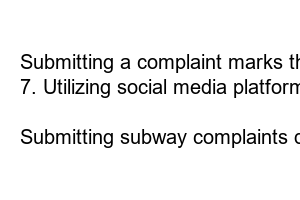지하철 민원 넣는 법
Title: Simplifying Subway Complaints: A Hassle-Free Guide to Submitting Feedback
Introduction:
Have you ever encountered a frustrating experience during your subway commute? Whether it’s a delayed train, faulty equipment, or unhelpful staff, these occurrences can ruin an otherwise pleasant day. However, instead of grumbling to yourself, there are effective ways to address these issues. In this blog post, we’ll provide you with valuable insights on submitting subway complaints and how to ensure your voice is heard.
1. Why should you bother submitting a complaint?
A subway complaint may seem trivial, but remember, providing feedback is crucial for improvement. By sharing your concerns, you contribute to enhancing the overall subway experience for yourself and other commuters.
2. Identifying the right channels to submit your complaint:
To ensure your complaint reaches the appropriate authorities, it’s important to choose the correct platform. Most transit agencies have dedicated customer service hotlines, email addresses, or digital complaint forms on their websites. Use these channels to report your grievances promptly.
3. Making your complaint concise and impactful:
When submitting a complaint, it’s essential to concisely articulate your experience. Avoid lengthy sentences or unnecessary details that might dilute the key points. Instead, focus on the core issue and explain how it impacted your journey. A well-structured complaint helps the recipient understand your concerns effortlessly.
4. Providing necessary details:
To expedite the resolution process, include vital details in your complaint. These could include the specific time, date, and location of the incident, as well as any relevant train line or station information. Such details help authorities investigate and address your complaint more effectively.
5. Offering constructive feedback:
While it’s natural to feel frustrated when writing a complaint, remember to approach it constructively. Instead of solely expressing dissatisfaction, suggest potential solutions or improvements that could prevent similar incidents in the future. This shows your commitment to bettering the subway system.
6. Following up to ensure action is taken:
Submitting a complaint marks the first step, but it’s equally important to follow up on your feedback. If you haven’t received a response within a reasonable time frame, don’t hesitate to reach out again. Persistence demonstrates your dedication to resolving the issue.
7. Utilizing social media platforms for escalated complaints:
In some cases, escalating your complaint on social media platforms can yield results. Many transit agencies actively monitor their social media channels and promptly address public complaints to maintain their reputation. However, reserve this approach for severe or unresolved issues.
Summary:
Submitting subway complaints doesn’t have to be a cumbersome process. By identifying the right channels, creating concise and impactful complaints, providing necessary details, offering constructive feedback, following up, and occasionally leveraging social media, you can contribute to a better subway experience. Your voice matters, and by actively participating in the feedback process, you play a vital role in improving the efficiency and quality of subway services.

